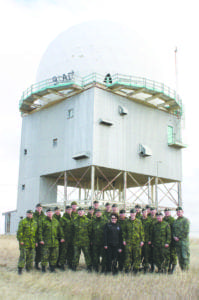Kenneth Brown
of The Crossroads
An organization focused on Canadian civil defence history has purchased the radar dome near Alsask and the organization has plans for the heritage property.
The radar dome, or radar tower, has been purchased by the Canadian Civil Defence Museum Association (CCDMA). A spokesperson for the association says the sale first became effective on June 1. The radar dome property was acquired from a private owner.

Members of the Canadian Forces Base Edmonton 1CMBG HQ&SIGS gather for a group photo by the radar dome in October 2012 during a visit to the former Canadian Forces Station Alsask. The radar dome located northwest of Alsask has been purchased by the Canadian Civil Defence Museum Association.
The radar dome was operated by Canadian Forces Station (CFS) Alsask and it was part of the Pinetree Line, a series of radar stations across the United States and Canada established in the 1950s to detect potential aerial attacks by the Soviet Union during the Cold War era.
According to the CCDMA website, CFS Alsask was first conceived as Royal Canadian Air Force (RCAF) Station Alsask in 1959 and it became CFS Alsask in 1967. The station was built in the early 1960s and it became fully operational as part of the North American Aerospace Defense Command (NORAD) network by 1963.
[emember_protected for=”2″ custom_msg=’For more on this story, please see the Jun. 29 print edition of The Cross Roads.’]
As stated on the website, RCAF Station Alsask was officially established on Nov. 1, 1962 and military personnel operated the station until Aug. 1, 1987 when they disbanded. The former village of Alsask took control of the property.
The village amalgamated with the Rural Municipality of Milton and the municipality has been trying to sell CFS Alsask assets since as early as 2010. The RM of Milton has made multiple calls for tenders and the radar dome was one of the assets up for sale.
Robin Busby, the municipality’s administrator, provided the minutes from a meeting on Jan. 14, 2015, when the sale was approved. The sale of the radar dome property was approved for $15,000 pending a mortgage approval and an engineering report. The property has a municipal heritage designation, so nothing could be done to the structure or property without consent from the municipality.
The administrator said the CCDMA has been in contact with the municipality before, but that conversation was “not necessarily about that dome.” The property was purchased by a private owner in 2015 looking to turn it into an observatory, but the owner sold it to the association.
Fred Armbruster, founder and executive director of the CCDMA, said the association is the only group in Canada focused on preserving the country’s civil defence emergency preparedness history. The association was officially established in 2012.
Civil defence has been a term used to describe relationship between the civilian population and the Department of National Defence (DND), so the relationship led to the development of civil defence infrastructure. The Pinetree Line is part of the infrastructure and it was crucial for protection, he said. He was working on a project for the Pinetree Line, and he did not know about the radar dome in Alsask.
Armbruster, who is from Melville, Sask., said he found out about the radar dome at Alsask and he learned that it happened to be the best preserved site out of any Pinetree Line or Dew Line radar site that is known to exist. He said he is a photographer and he makes photo documentaries.
He made arrangements in 2015 to visit the radar dome site for the purpose of doing a photo documentary, so he met the private owner. He said he cringed at the idea of transforming the radar dome into an observatory because it meant changes to the structure.
The former owner contacted the association because he was interested to sell the property and he knew the association would take good care of the dome in the interest of preservation, and he offered the property to the CCDMA.
“I talked with our directors and we all agreed that this would be very important for us to do,” Armbruster said of idea to purchase the dome. “We were able to get a private sponsor to fund the acquisition, and so we purchased it and we took possession.”
A group from the association visited the site on June 1 – the day ownership changed hands. The new owners wanted to show the community they were serious about the site and their future plans, so they spent time cleaning up of the property.
The group did some landscaping, cut the grass, cleared debris from the roadway and installed signs, he said. There has been trouble with people trespassing on the property and breaking into the structure, so the owners have also taken steps to improve security at the property. Trespassing is a threat to preservation, and he stressed that the tower at Alsask is unlike any other tower in existence.
“It’s the only radar dome on the Pinetree Line to have its original dome,” Armbruster said, recognizing that other existing radar towers are gutted and destroyed. “This is providing a huge opportunity for us to preserve Canadian history in Saskatchewan and abroad.”
The association spent $10,000 cleaning up the property, he said. There were two other radar towers on the property at one time, but the two other towers were demolished and buried. He said the association has plans to recover the domes.
He noted that a long-term plan is to turn the property into a tourist attraction. The owners would like to embark on a restoration project to rebuild the other two domes on the ground and turn the domes into an interpretive centre and a restaurant, he explained. The plans depend on funding, and people could visit www.civildefencemuseum.ca to find out how to support the association, he commented.
Armbruster said the CCDMA is based in Edmonton at the present time, but the association is in the process of moving to Red Deer. The association is non-profit, charitable organization that does not have its own museum space, so it works with other museums.
“We’re here to tell a story because no one else ever has,” he said, recognizing that Canada’s civil defence history is not very well documented and the association will set the record straight by telling the stories relating to civil defence. “There are a lot of uneducated comments out there about how safe we were and our technology, but we had the state-of-the-art technology to monitor the skies.”
Bill Warrington, a resident of the Loverna-Hoosier area, is a local historian, chairperson for the Kindersley & District Plains Museum and councillor for Antelope Park. He said he has great interest in the radar dome due to the role it played in Canadian history.
“I hope it stays there for a while because it’s pretty unique for this part of the country,” Warrington said, recognizing that he heard about the recent sale to the CCDMA and he hopes the group is able to accomplish its goals.
He noted that he has an interesting history with the radar dome site. He said he was at the property when they demolished the other two radar towers, and it broke his heart to see the structures disappear. He even operated the back hoe to dig a large hole where the materials were buried at the property.
Warrington said the towers were dismantled because officials believed they were a liability. He recalled seeing the site lit up from his property when he was young. The historian said RCAF planes would fly as low as possible to test the site’s radar capabilities.
“They used to come down from Cold Lake with the airplanes and they would fly in really low to see if they could sneak into Alsask before the domes would catch it,” he said, adding the planes would make a thunderous roar.


I was in Alsask from 1978-1981 inclusive
Many happy memories